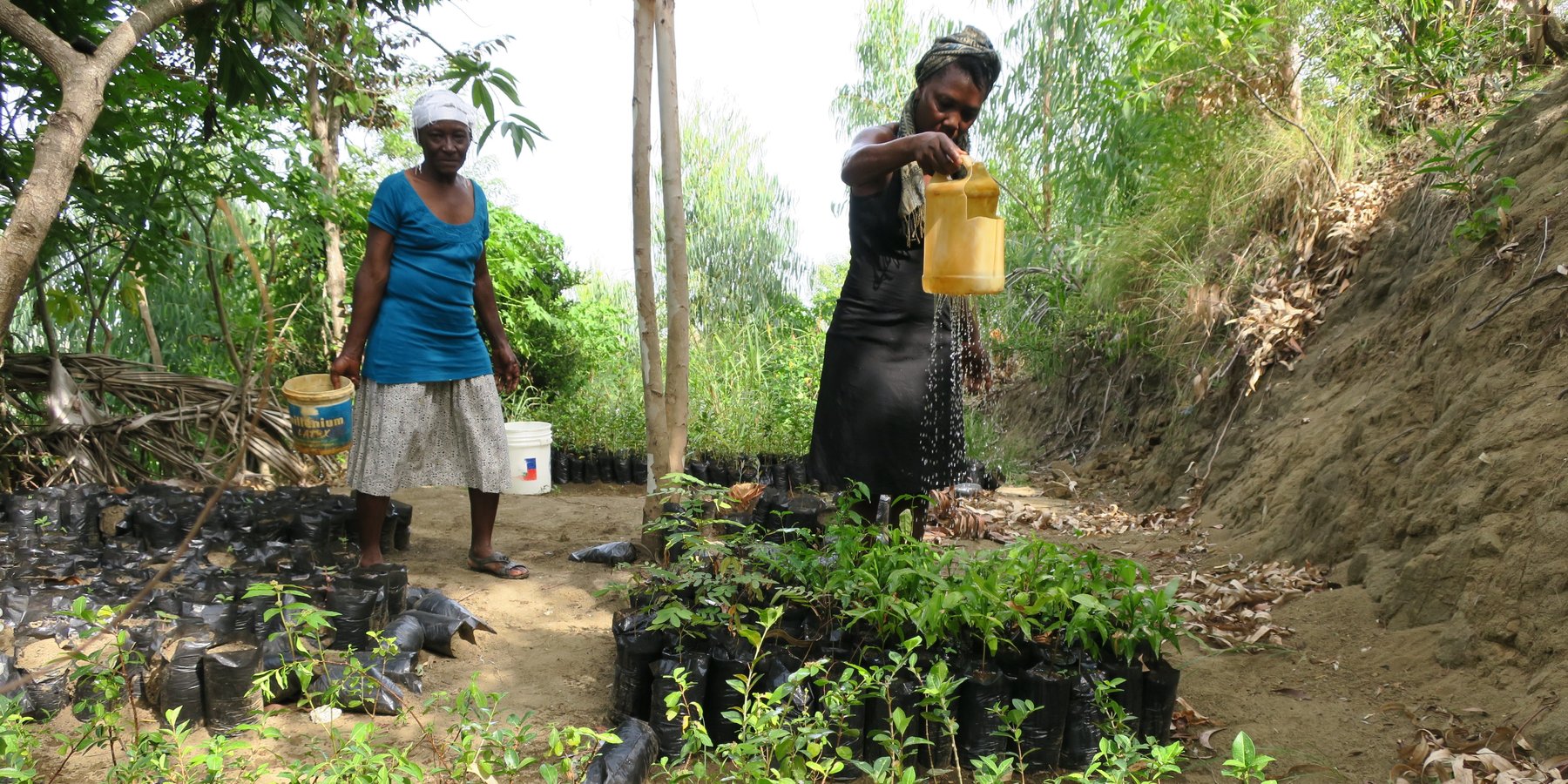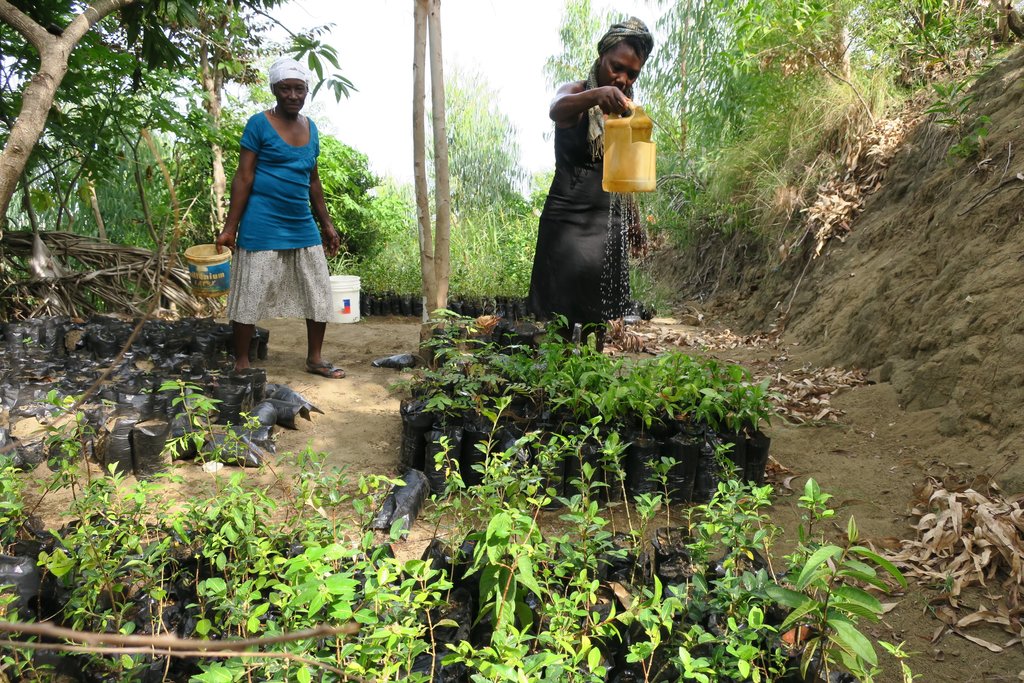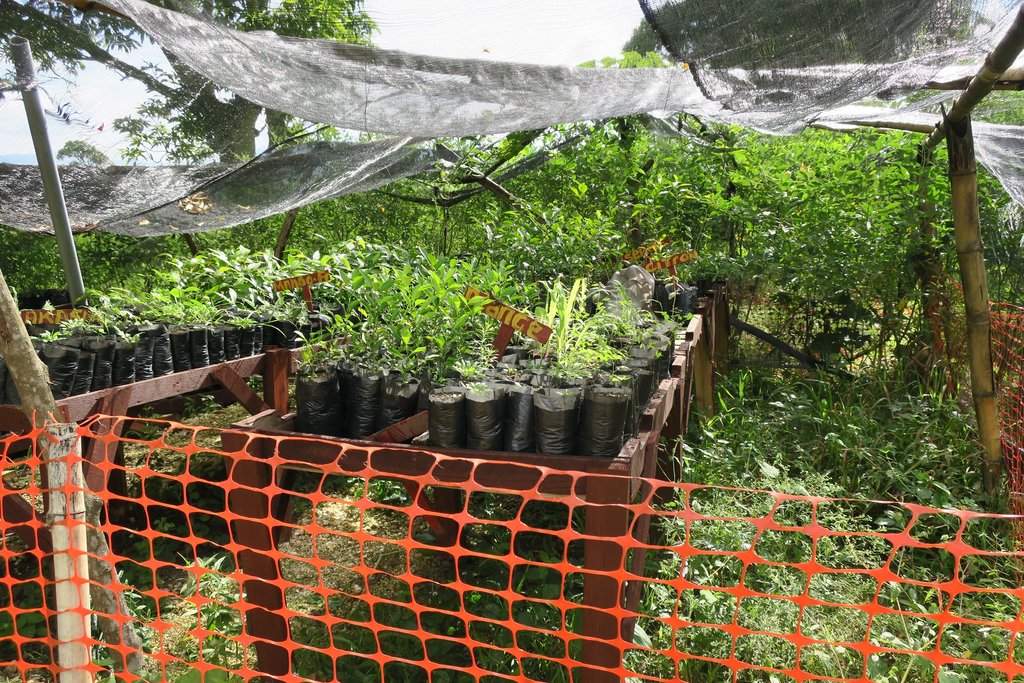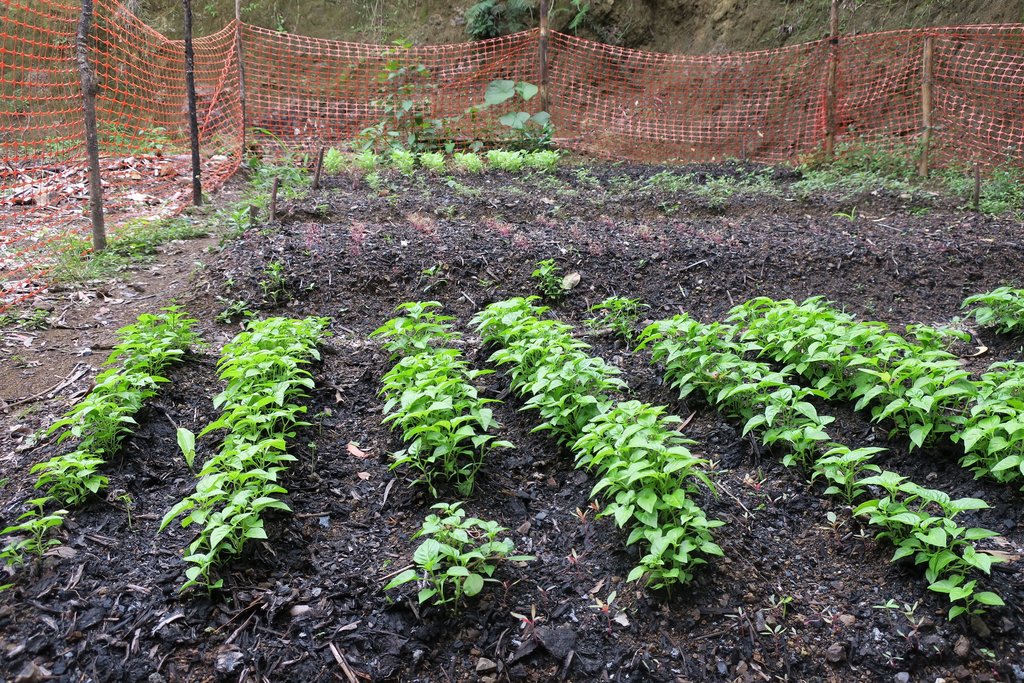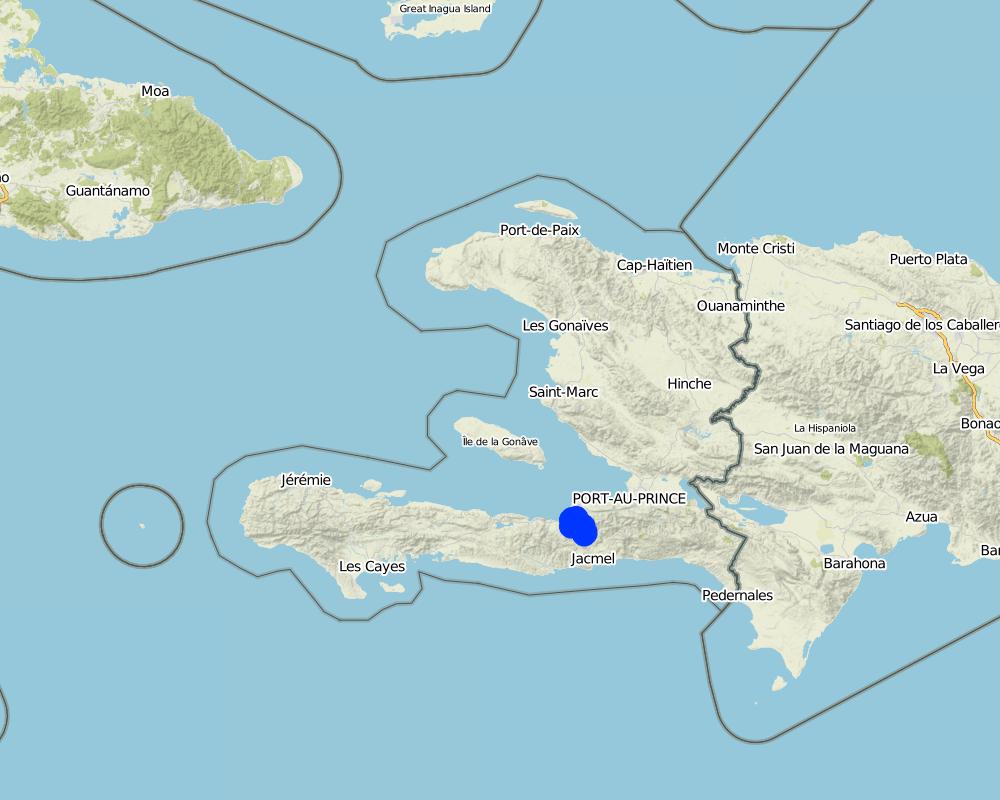afforestation [Haiti]
- Creation:
- Update:
- Compiler: Joana Eichenberger
- Editors: Jean Carls Dessin, Hanspeter Liniger
- Reviewer: Hanspeter Liniger
Afforestation
approaches_3284 - Haiti
View sections
Expand all Collapse all1. General information
1.2 Contact details of resource persons and institutions involved in the assessment and documentation of the Approach
Key resource person(s)
Technicien agroecologie:
Jeune Loius
Crois Rouge Suisse
Haiti
Name of the institution(s) which facilitated the documentation/ evaluation of the Approach (if relevant)
Swiss Red Cross (Swiss Red Cross) - Switzerland1.3 Conditions regarding the use of data documented through WOCAT
When were the data compiled (in the field)?
23/11/2017
The compiler and key resource person(s) accept the conditions regarding the use of data documented through WOCAT:
Yes
1.4 Reference(s) to Questionnaire(s) on SLM Technologies
2. Description of the SLM Approach
2.1 Short description of the Approach
Dans les mornes à Léogâne, la Croix Rouge Suisse (CRS) pratique la reforestation en participation communautaire.
2.2 Detailed description of the Approach
Detailed description of the Approach:
Un des projets de la Croix Rouge Suisse à Léogâne est l’afforestation. Il s’agit d’une approche participative avec les OCBs (organisations communautaires de base) et les exploitants des terres. Il est essentiel de sensibiliser les membres des OCB et leurs voisins à la valeur des services écosystémiques des arbres et des forêts et de les motiver à coopérer.
L’objectif de cette approche est de reboiser certaines parties des mornes pour restaurer l'environnement ou bien pour réduire les risques de catastrophes basé sur la gestion des écosystèmes. Cependant, la Croix Rouge Suisse exige la coopération des OCB et la participation des exploitants des terres: les communes s’organisent eux-mêmes pour réaliser des pépinières et planter les plants. La Croix Rouge Suisse ne fournis que le savoir-faire et les petits sachets en plastique pour faire l’élevage les plantules qui ne sont pas disponible an Haïti.
Comme c’est une approche de participation communautaire les techniciens de la CRS font beaucoup de sensibilisation. D’abord l’équipe de la Croix Rouge Suisse doit sensibiliser les représentants des OCBs pour qu’ils participent du projet. Ensuite, les OCBs doivent motiver tous les gens de la communauté à collaborer. C’est aux OCBs de choisir les endroits adéquats à reboiser. Une fois choisit une parcelle (et approuvé par les techniciens de la Croix Rouge Suisse), les OCBs peuvent commencer avec la mise en place des pépinières. Après quatre mois les plants sont prêts à être planté. Les membres des OCBs et les habitants de la communauté les plantent à system pluviale.
Ce que les exploitants des terres aiment au sujet de l’approche c’est qu’ils peuvent participer à restaurer l’environnement. Ils sont conscients des bénéfices des arbres concernant la dégradation des terres. Par contre ce qu’ils n’aiment pas vraiment c’est le fait qu’avec la reforestation ils perdent de l’espace cultivable.
2.3 Photos of the Approach
2.5 Country/ region/ locations where the Approach has been applied
Country:
Haiti
Region/ State/ Province:
Département d'Ouest, Léogâne
Further specification of location:
Léogâne
Comments:
Quelques pépinières soutenus par la CRS
Map
×2.6 Dates of initiation and termination of the Approach
If precise year is not known, indicate approximate date when the Approach was initiated:
less than 10 years ago (recently)
2.7 Type of Approach
- project/ programme based
2.8 Main aims/ objectives of the Approach
Dans un bassin versant reforestation sert comme technologie de gestion des risques de désastre: En stabilisant le sol et en améliorant l'infiltration de l'eau, les arbres protègent les villes, les champs et les infrastructures en avale contre des glissements de terre et des inondations.
2.9 Conditions enabling or hindering implementation of the Technology/ Technologies applied under the Approach
social/ cultural/ religious norms and values
- enabling
availability/ access to financial resources and services
- enabling
collaboration/ coordination of actors
- enabling
knowledge about SLM, access to technical support
- enabling
markets (to purchase inputs, sell products) and prices
- enabling
workload, availability of manpower
- enabling
3. Participation and roles of stakeholders involved
3.1 Stakeholders involved in the Approach and their roles
- local land users/ local communities
Les gens de la zone, toutes les catégories (femmes, hommes, jeunes, âgées...)
Le soin de la forêt, entretien
- community-based organizations
Organisations communautaires de base (OCBs) (femmes, hommes, jeunes, âgées...)
Sensibilisation, mise en place et soin des pépinière, planter les plants, soin de la forêt
- SLM specialists/ agricultural advisers
Techniciens de la Croix Rouge Suisse (seulement de hommes, jeunes-âgés)
Sensibilisation, appuie techniquement
- local government
Autorités locales: Conseil de l'administration communale (Cazec) pour les sections communales et l'assemblé des section communale (ASE) pour les "habitation", (hommes et femmes, avec des quota pour les femmes)
L'administration
- international organization
Croix Rouge Suisse
Appuie les OCB (organisations communautaires de base), fournis les techniciens, donne un plat chaud pour les gens que travaillent
3.2 Involvement of local land users/ local communities in the different phases of the Approach
| Involvement of local land users/ local communities | Specify who was involved and describe activities | |
|---|---|---|
| initiation/ motivation | interactive | |
| planning | interactive | |
| implementation | interactive | Les OCB sont très actives. Les exploitant de terre suivent les ordres de l'OCB. La CRS ne peut pas agir sans les OCBs. Idéalement la parcelle appartient à un membre de l'OCB. Comme ça il faut juste sensibiliser les voisins. Si l'espace n’appartient pas à un membre de l'OCB, c'est plus compliqué. Il faut donc sensibiliser le propriétaire et le convaincre des bénéfices de la reforestation. |
| monitoring/ evaluation | interactive | Les voisins participent à la protection, OCB doit faire de la sensibilisation pour que les gens protègent |
3.3 Flow chart (if available)
Description:
La CRS n'en a pas. Les processus pus importans: Identification et sélection de l'éspace, préparation du sol, plantation, entretien
3.4 Decision-making on the selection of SLM Technology/ Technologies
Specify who decided on the selection of the Technology/ Technologies to be implemented:
- all relevant actors, as part of a participatory approach
Explain:
OCB avec l'appuie technicien de la CRS
Specify on what basis decisions were made:
- evaluation of well-documented SLM knowledge (evidence-based decision-making)
4. Technical support, capacity building, and knowledge management
4.1 Capacity building/ training
Was training provided to land users/ other stakeholders?
Yes
- les OCB
Form of training:
- on-the-job
- demonstration areas
- public meetings
- courses
Subjects covered:
stabilisation de sol sur le ta;
4.2 Advisory service
Do land users have access to an advisory service?
Yes
Specify whether advisory service is provided:
- on land users' fields
4.3 Institution strengthening (organizational development)
Have institutions been established or strengthened through the Approach?
- yes, a little
Specify the level(s) at which institutions have been strengthened or established:
- local
Describe institution, roles and responsibilities, members, etc.
OCB
- appuie technique
4.4 Monitoring and evaluation
Is monitoring and evaluation part of the Approach?
Yes
If yes, is this documentation intended to be used for monitoring and evaluation?
Yes
4.5 Research
Was research part of the Approach?
No
5. Financing and external material support
5.1 Annual budget for the SLM component of the Approach
If precise annual budget is not known, indicate range:
- < 2,000
Comments (e.g. main sources of funding/ major donors):
HTG:
5.2 Financial/ material support provided to land users
Did land users receive financial/ material support for implementing the Technology/ Technologies?
Yes
If yes, specify type(s) of support, conditions, and provider(s):
OCB: Sachets pour la pepinère
pour une activité oficielles: plat chaut pour les participants
5.3 Subsidies for specific inputs (including labour)
- construction
| Specify which inputs were subsidised | To which extent | Specify subsidies |
|---|---|---|
| petits sachets pour la pépinière | fully financed | |
If labour by land users was a substantial input, was it:
- voluntary
Comments:
plat chaud dans le cadre d'une acrivité oficielle
5.4 Credit
Was credit provided under the Approach for SLM activities?
No
5.5 Other incentives or instruments
Were other incentives or instruments used to promote implementation of SLM Technologies?
No
6. Impact analysis and concluding statements
6.1 Impacts of the Approach
Did the Approach empower local land users, improve stakeholder participation?
- No
- Yes, little
- Yes, moderately
- Yes, greatly
Ils sont intéressés à protéger la forêt et ils participent. Ils sont fiers de ses ouvres.
Did the Approach help land users to implement and maintain SLM Technologies?
- No
- Yes, little
- Yes, moderately
- Yes, greatly
C'est une approche participative, ils font tout eux-mêmes.
Did the Approach improve coordination and cost-effective implementation of SLM?
- No
- Yes, little
- Yes, moderately
- Yes, greatly
Surtout à long terme il y a beaucoup de bénéfices.
Did the Approach mobilize/ improve access to financial resources for SLM implementation?
- No
- Yes, little
- Yes, moderately
- Yes, greatly
Ça coût mois en terme de capital financier.
Did the Approach improve knowledge and capacities of land users to implement SLM?
- No
- Yes, little
- Yes, moderately
- Yes, greatly
C'est comme une expérience pilote. Ça va aider les gens à le faire chez eux.
Did the Approach improve knowledge and capacities of other stakeholders?
- No
- Yes, little
- Yes, moderately
- Yes, greatly
Les exploitants des terres qui n’appartiennent pas à une organisation ne sont pas vraiment inclue parce qu'ils sont moins fiables: des fois on pense qu'il y aura 7 participants mais seulement 2 arrivent.
Did the Approach build/ strengthen institutions, collaboration between stakeholders?
- No
- Yes, little
- Yes, moderately
- Yes, greatly
Des fois les OCBs gainent des nouveaux membres.
Did the Approach empower socially and economically disadvantaged groups?
- No
- Yes, little
- Yes, moderately
- Yes, greatly
La fertilité du sol va augmenter et du coup ces gens auront plus de rendement (peut planter le café).
Did the Approach improve gender equality and empower women and girls?
- No
- Yes, little
- Yes, moderately
- Yes, greatly
Ce sont surtout des femmes qui d'occupent des pépinières.
Did the Approach encourage young people/ the next generation of land users to engage in SLM?
- No
- Yes, little
- Yes, moderately
- Yes, greatly
Le jeune se rendent compte des bénéfices écologiques des forêts.
Did the Approach improve issues of land tenure/ user rights that hindered implementation of SLM Technologies?
- No
- Yes, little
- Yes, moderately
- Yes, greatly
L'approche demande que tout le monde met ensemble ses parcelles, mais ce n'est pas tous les gens qui sont d'accord.
Did the Approach lead to improved food security/ improved nutrition?
- No
- Yes, little
- Yes, moderately
- Yes, greatly
Mais seulement à long terme (une 10ène d'années)
Did the Approach improve access to markets?
- No
- Yes, little
- Yes, moderately
- Yes, greatly
Peut-être en terme touristique, ça peut attirer des gens qui aiment la nature.
Did the Approach lead to improved access to water and sanitation?
- No
- Yes, little
- Yes, moderately
- Yes, greatly
A l'eau, parce que le débit des sources devrait augmenter. Même les sources sèches devraient réapparaître.
Did the Approach lead to more sustainable use/ sources of energy?
- No
- Yes, little
- Yes, moderately
- Yes, greatly
Did the Approach improve the capacity of the land users to adapt to climate changes/ extremes and mitigate climate related disasters?
- No
- Yes, little
- Yes, moderately
- Yes, greatly
Les services écosystémiques des forêts sont mis à valeur: Grâce à la nouvelle couche végétale, l'impact de la pluie sur le sol est diminué, l'infiltration de l'eau dans les sols est améliorée et les forêts servent aussi comme des brise-vent.
Did the Approach lead to employment, income opportunities?
- No
- Yes, little
- Yes, moderately
- Yes, greatly
Après de 10ènes des années on a les revenus p.ex. du café ou du cacao.
6.2 Main motivation of land users to implement SLM
- increased production
à long terme
- reduced land degradation
à long terme
- reduced risk of disasters
à long terme
- environmental consciousness
- enhanced SLM knowledge and skills
- aesthetic improvement
La beauté de la région
6.3 Sustainability of Approach activities
Can the land users sustain what has been implemented through the Approach (without external support)?
- yes
If yes, describe how:
Ce pour ça que la CRS a priorisé cette approche participative.
6.4 Strengths/ advantages of the Approach
| Strengths/ advantages/ opportunities in the land user’s view |
|---|
| Après la sensibilisation ils voient les bénéfices comme la protection de l'environnement. |
| Strengths/ advantages/ opportunities in the compiler’s or other key resource person’s view |
|---|
| Restauration de l'environnement physique |
6.5 Weaknesses/ disadvantages of the Approach and ways of overcoming them
| Weaknesses/ disadvantages/ risks in the land user’s view | How can they be overcome? |
|---|---|
| Moins de terre cultivable | Sensibilisation |
| L'espace inaccessible aux bétails | Sensibilisation |
| Weaknesses/ disadvantages/ risks in the compiler’s or other key resource person’s view | How can they be overcome? |
|---|---|
| C’est un travail à long terme. | |
| Nécessite beaucoup d'énergie |
7. References and links
7.1 Methods/ sources of information
- field visits, field surveys
Visites de 3 pépinières, visite de rampes vivantes qui sont affrétés.
- interviews with SLM specialists/ experts
Technicien agroécologie
Links and modules
Expand all Collapse allLinks
No links
Modules
No modules


